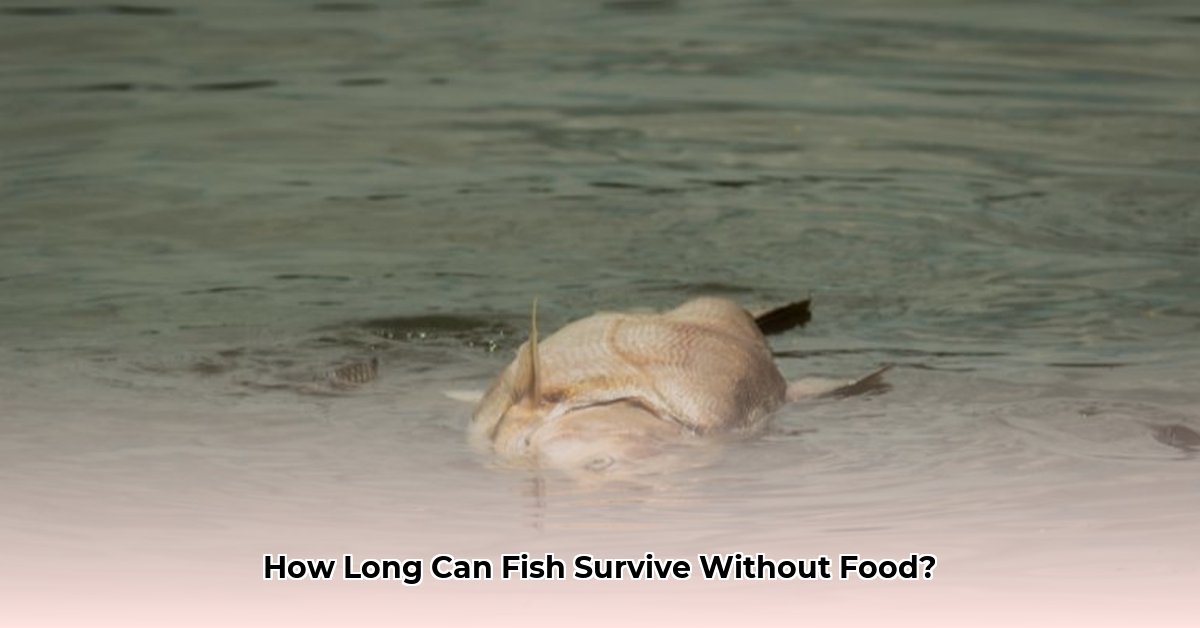Going on a trip? Worried about your fish? It’s a common concern, but fish are often more resilient than we think. This comprehensive guide covers everything you need to know about how long fish can survive without food, from understanding the factors at play to preparing your tank for your absence.
Decoding Fish Fasting
So, just how long can a fish go without food? It’s not a simple answer. Several factors influence a fish’s fasting ability, making it a fascinating puzzle to unravel.
Factors Affecting Survival Time
Think of these factors as pieces of the puzzle, each contributing to the overall picture:
- Species: Some fish, like goldfish, are naturally hardy and can go longer without food, potentially up to two weeks or even more. Other species, like certain tetras, have faster metabolisms and probably require more frequent meals. Research suggests this may be linked to evolutionary adaptations to their natural environments.
- Age & Size: Larger, older fish generally have more stored energy reserves, similar to how a larger car has a bigger gas tank. Younger, smaller fish, much like growing children, require more consistent nourishment.
- Water Temperature: Colder water slows a fish’s metabolism, allowing them to conserve energy and potentially fast for longer. Warmer water increases metabolism and may necessitate more frequent feedings.
- Water Quality: Clean water is paramount. Poor water quality adds stress, depleting energy reserves faster.
- Activity Level: A highly active fish burns more energy, similar to a marathon runner, and may likely require more frequent meals compared to a less active fish.
- Overall Health: A healthy fish is always better equipped to handle stress, including periods without food. Pre-existing health issues might reduce a fish’s ability to fast.
Species-Specific Survival Estimates
While general guidelines are helpful, a fish’s actual fasting ability depends on the interplay of the above factors. Here’s a general overview, but always research your specific fish’s needs:
| Species | Estimated Survival Time (Without Food) | Notes |
|---|---|---|
| Betta | 7-10 days | Can potentially tolerate longer, but monitor closely. |
| Goldfish | 1-2 weeks (possibly longer) | Known for their hardiness. |
| Guppies | 5-7 days | Smaller fish may need monitoring. |
| Tetras | 3-5 days | Highly variable depending on the specific type. |
| Danios | Up to 14 days | Active fish; automatic feeders can be very helpful. |
| Angelfish | 5-7 days | |
| Rasboras | Up to 7 days | |
| African Cichlids | 5-7 days | |
| Platies | 5-14 days | |
| Mollies | 5-14 days | |
| Plecos | 4-14 days | Algae eaters, may graze on algae growth. |
| Oscars | Up to 7 days | |
| Swordtail Fish | 5-14 days | |
| Corydoras Catfish | 5-14 days | Bottom feeders, may scavenge for food. |
| Barbs | Up to 7 days | |
| Discus | Up to 5 days | Sensitive fish, require close monitoring. |
| Loaches | Up to 7 days | |
| Gouramis | Up to 10 days | |
| Koi | 2-4 weeks | In established ponds, particularly in cooler temperatures. |
Hunger Games: Fish Edition
While fish can’t tell you they’re hungry, they can show you. Look for these possible signs:
- Increased Activity Near Feeding Spot: Are they constantly hovering where you usually drop food?
- Lethargy: Are they less active than usual?
- Hiding: More time spent in hiding could indicate stress, possibly from hunger.
- Weight Loss: A more prominent lateral line suggests weight loss.
- Color Changes: Faded colors can be a sign of stress or poor nutrition.
- Other Appetite Changes: ignoring previously enjoyed food.
Preparing for Your Absence: A How-To Guide
Leaving for a while? Here’s how to ensure your fish are well-fed:
1. Choose Your Feeding Method:
- Automatic Feeders: These programmable devices dispense food at set intervals. Test it thoroughly before your trip!
- Slow-Release Food Blocks: These dissolve slowly, providing food over time. Suitable for shorter trips.
- Fish Sitter: The best option for longer trips, offering personalized care. Provide very specific instructions.
2. Tank Prep Checklist:
- Clean Tank: A partial water change and filter cleaning before you leave helps minimize waste buildup.
- Temperature Adjustment (if applicable): Slightly lowering the temperature (within the safe range for your fish) can slow metabolism. Research your fish’s specific temperature requirements.
3. Before You Go:
- Final Fish Check: Observe your fish for any signs of illness beforehand.
- Double-Check Everything: Ensure your chosen feeding method is working correctly and the tank is in optimal condition.
Returning Home: Reintroducing Food
Back from your adventures? Ease your fish back into their regular feeding routine:
- Gradual Feeding: Start with small amounts and gradually increase over a few days. This helps their digestive systems readjust.
- Observation: Monitor your fish closely for any signs of illness or stress.
Advanced Aquarium Practices
For long-term peace of mind:
- Planted Tanks: Live plants provide a supplementary food source and improve water quality, creating a more stable ecosystem.
- Nutritional Planning: Researching their specific dietary needs and providing a varied, high-quality diet contributes to overall fish health and resilience.
FAQs
- Can I overfeed before leaving? No! Overfeeding pollutes the water and is far more dangerous than missing a few meals.
- Are all automatic feeders the same? No, research to find a reliable model suitable for your fish and tank size.
By understanding these elements, you can feel confident leaving your fish in good hands – even if those hands are a programmable feeder! Remember, responsible fishkeeping involves understanding their unique needs and providing the best possible care, even in your absence.
- Post 1 - October 30, 2025
- Enterprise Mobile App Development: How To Measure Room Temperature - October 14, 2025
- Google CBS Mobile App: Is CBS Charging Mobile Users? - October 13, 2025









